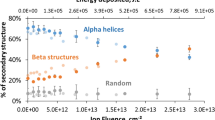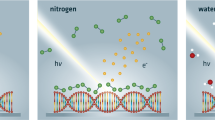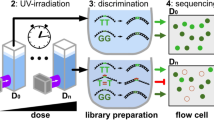Abstract
WHEN purine and pyrimidine nucleotides in dilute aqueous solution are irradiated with ionizing radiation they are destroyed by two pathways1. The minor pathway is attack upon the sugar moiety followed by release of free base1. Details of the mode of sugar attack have not been established; but possible reactions have been suggested by Daniels et al. 2. The major pathway is attack of the base moiety which with purines in the absence of oxygen yields the corresponding formamido-pyrimidine nucleotide3. When pyrimidine nucleotides are irradiated in the absence of oxygen sugar phosphate is liberated, but there is no ultra-violet absorbing product arising from base attack. When oxygen is present during irradiation G-values (molecules per 100 eV.) for nucleotide destruction are increased 2–3 times4. For purine nucleotides the increased degradation in oxygen is almost entirely an augmented base attack, but no ultra-violet product arising from it is found4. When pyrimidines are irradiated in the presence of oxygen hydroxy-hydroperoxides are formed5. G-values for destruction of pyrimidines in the presence of oxygen are greater than those for purines1,6 and suggest that when deoxyribonucleic acid is irradiated pyrimidines will be destroyed to a greater extent. Extrapolation of the effects of radiation upon nucleotides to effects upon deoxyribonucleic acid is complicated in an uncertain way by the influence of inter-nucleotide linkages and hydrogen bonding of base pairs. This communication reports the amounts of base and sugar destroyed when aqueous solutions of calf thymus deoxyribonucleic acid are irradiated.
This is a preview of subscription content, access via your institution
Access options
Subscribe to this journal
Receive 51 print issues and online access
$199.00 per year
only $3.90 per issue
Buy this article
- Purchase on Springer Link
- Instant access to full article PDF
Prices may be subject to local taxes which are calculated during checkout
Similar content being viewed by others
References
Scholes, G., and Weiss, J., Exp. Cell. Res., Supp. 2, 219 (1952).
Daniels, M., Scholes, G., and Weiss, J., J. Chem. Soc., 3771 (1956).
Hems, G., Nature, 181, 1721 (1958).
Hems, G., Rad. Res. (in the press).
Scholes, G., and Weiss, J., Nature, 185, 305 (1960).
Barron, E. S. G., Johnson, P., and Cobure, P., Rad. Res., 1, 410 (1954).
Wyatt, G. R., Biochem. J., 48, 584 (1951).
Korn et al., J. Amer. Chem. Soc., 75, 3610 (1953).
Gray, L. H., Rad. Res., Supp. 1, 73 (1959).
Author information
Authors and Affiliations
Rights and permissions
About this article
Cite this article
HEMS, G. Chemical Effects of Ionizing Radiation on Deoxyribonucleic Acid in Dilute Aqueous Solution. Nature 186, 710–712 (1960). https://doi.org/10.1038/186710b0
Issue Date:
DOI: https://doi.org/10.1038/186710b0
This article is cited by
-
6-Amino-8-hydroxy-7,8-dihydro-purine: Radiation Product of Adenine
Nature New Biology (1971)
-
Zur Strahlenwirkung auf Diphosphorpyridinnucleotid
Biophysik (1963)
Comments
By submitting a comment you agree to abide by our Terms and Community Guidelines. If you find something abusive or that does not comply with our terms or guidelines please flag it as inappropriate.



